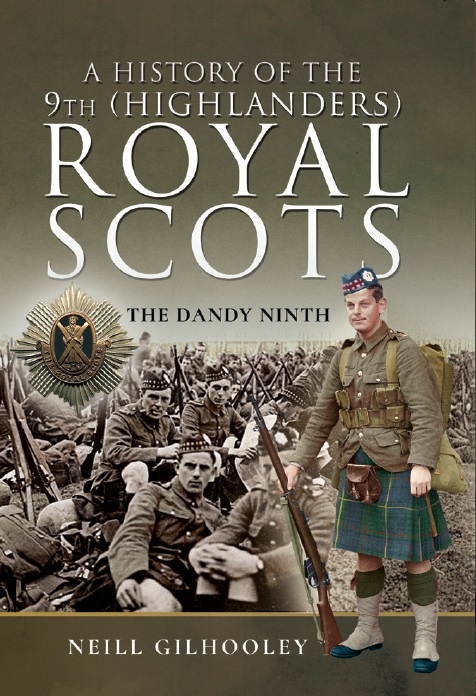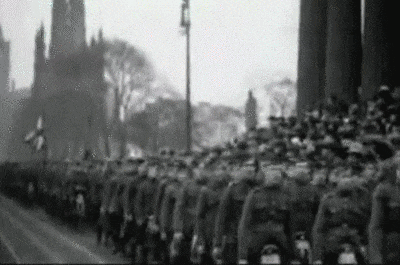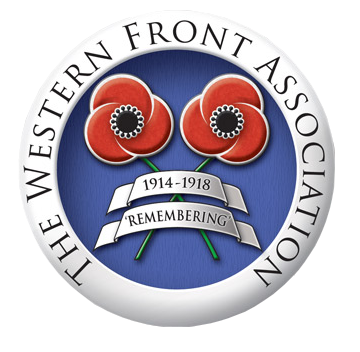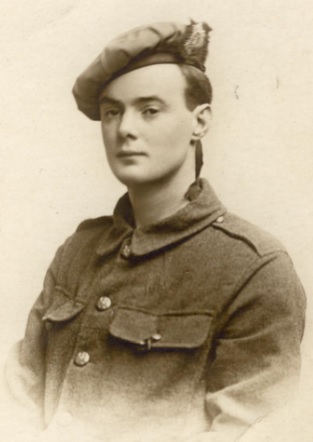A History of the 9th (Highlanders) Royal Scots, The Dandy Ninth, Neill Gilhooley, foreword by Nigel Cave, published 6 December 2019 by Pen&Sword.


Edinburgh is forever bound to The Royal Scots, the oldest regiment in the British Army and now part of The Royal Regiment of Scotland. For a period in the early twentieth century, it also had a Highland battalion, the kilted 9th Royal Scots, which became affectionately known as the Dandy Ninth. The battalion was formed in the aftermath of the Boer War’s Black Week. It sent volunteers to South Africa and established itself as Edinburgh’s kilted battalion, part of the Territorial Force.
Mobilised in 1914 as part of the Lothian Brigade, they defended Edinburgh and environs from the threat of invasion, and constructed part of the landward defences around Liberton Tower. They were part-time soldiers and new recruits, drawn from the breadth of society but with a strong representation of lawyers, rugby players and artists such as the Scottish Colourist F.C.B. Cadell, and William Geissler of the Edinburgh School. A remarkably high proportion of the battalion received commissions and served in many branches of the armed forces, and in many theatres.
In the Great War they mobilised to France and Flanders and served in many of the major actions: in Ypres in both the Second and Third (Passchendaele) Battles of Ypres as well as on the Somme 1916 at High Wood and the Ancre (Beaumont Hamel), at Arras 1917 (Vimy Ridge); at Cambrai 1917 (Fontaine); and during the 1918 German Spring Offensive at St Quentin and at the Battle of Soissonais-Ourcq. They were with the 15th (Scottish) Division in the Advance to Victory.
Some 6,000 men passed through the ranks of the Dandy Ninth and over a thousand never returned.
Photograph is of Benny Irvine courtesy John Johnston
The major actions they participated in were:
- Second Ypres (April-May 1915)
- High Wood (July 1916)
- Beaumont Hamel (November 1916)
- Arras (April 1917)
- Third Ypres – Passchendaele (September 1917)
- Cambrai (November-December 1917)
- Michael – Saint Quentin (March 1918)
- Lys (April 1918)
- Soissons (August 1918)
- Hundred days (to November 1918)

9th Royal Scots march past on Princes Street, 20th November 1921
Podcast

The Western Front Association podcast ‘Mentioned in Desptaches’ by Dr Tom Thorpe, episode 180, ‘9th Royal Scots in the GW’
Index
An index of personnel is here https://neillgilhooley.com/9th-royal-scots/index/
Notes and Clarifications
Additions welcome! The sentence most effected is from page 234.
p.xvi I had ‘far farther’ changed to ‘far further’. I had ‘to invidiously promote’, changed to ‘invidiously to promote’
p.3 I had Forth Infantry Brigade, changed to Firth of Forth Infantry Brigade
p.4 I use stark contrast four times – I should show more variety!
p.4 Regarding the ‘Dandy’ title, there are various references to the ‘Dandy Fifth’ – a Maryland battalion filmed on the march in 1899, a Boer war kommando and a comic opera of 1898, whereas the ‘Dandy Seventh’ was from New York.
p.4 Archibald Gordon’s brother, William Eagleson Gordon, Gordon Highlanders, was wounded at Magersfontein and decorated VC in 1900. As noted on p.64 he was aide-de-campe to George V in the Great War, but only after repatriation having been a POW
p.9 The section on the Imperial Yeomanry could either be shortened or expanded, but is perhaps too compressed at present
p.13 The image of Middelburg/Middleburg (Image 1-11 from HW Wilson) seems to come from H.F. Gros ‘Pictorial Description of the Transvaal’
p.17 acting state President should be Acting State President. It was not only Burger who arrived at Middelburg.
p.19 [whom] not [who]
p.20/21 and p.33 These were supposed to be full page (no margin) but among other things the trim size of the book changed between my contract and the print run
p.22 General Archibald Hunter
p.26 Comma not wanted after professionalism,
p.32 The photo is not Davie Bell’s postcard ( I have not seen the postcard, it might have been the same image or another from that camp)
p.41 This is a photo of one of the two armoured trains, I have not identified which one
p.43 Intended to be full page
p.45 This was never intended to be full page and looks overblown
p.48 Ross Haddon was put in charge of the officers from the SMS Mainz ‘On the occasion I had to purchase a Revolver (a weapon I had never fired). When the prisoners landed, bottles were thrown, I advanced a few paces in front of my party, got them into a charabanc and conveyed them to Castle. Army food not good enough and had to arrange with McVities & Guest to feed them.’ Memoir of Dr Haddon, courtesy Andrew Haddon. Among the other stories from his memoir, one of a ‘famous golfer’ having imbibed at the New Club one evening, was called out by an invasion scare and unable to find his boots, marched to Haddington in his stockings.
p.53 The crew are referred to as Hindus in more than one source, but as a cattle ship this seems unlikely – inverted commas have been used
p.59 I do not have forenames for WC McMillan (Pte, 1773)
p.61 ‘nearly 500 rounds each’ seems unlikely so perhaps deserved quote marks
p.62 The AA Gordon Society has a picture of him in Flanders
p.63 Intended to be full page
p.65 Extra inverted comma after picnic
p.68 The Cameron kilts are mentioned again in James Clark’s biography on p.303
p.74 Another account of Second Ypres is given in a letter by Ivan Tait in Daniel Stewart’s magazine
p.76 I really wanted the panorama pushed out to full width, the sketch could have been smaller
p.77 On reflection I should save the description of the final part of the attack until all four companies are present, rather than breaking here to follow A and B Coys, though this may be more or less chronological.
p.77 Twenty hit crossing the gap in Wieltje seems high for B Company’s total, but I have no basis to question it
p.79 Original had ‘but further advance was ordered’ this has been changed to read ‘a further’
p.80 ‘‘Dig!’ and that if they knew how serious it was they would be more energetic!’, this has lost the outer quote marks so that the quote only looks like ‘Dig!’
p.81 Two quotes have been rolled into one in making it a quote block
p.83 Andrew Dishington
p.84 26 April 1915 Drummer Philip C Houston ‘wounded 26 April, many small flesh wounds due to pieces of casing scattered about both legs and back. X Ray. numerous small fragments seen but not important enough to be worth removing.’ Could have been one of the stretcher bearers wounded that Cairns describes.
p. 84 William Young quote ‘the devil’s work’ has become corrupted
p.86 Another man given a funeral was Donald Grant, his body arriving on the mail train (wounded 24 April, died 20 May 1915 London)
p.93 I had ‘epiphany’, this has been changed to ‘epitome’.
p.99 The doctor who had his shelter reinforced would not have been Haddon, see the page on this site of Cairns’s diary for a list of medical personnel
p.101 Clarity needed over fires: permitted fires by night but needed to get the coke going before dawn as they were not allowed to make smoke. It was annoying to wake and find the fire had gone out as it was then difficult to get the coke burning. Cairns.
p.102 For some reason whereas changed to wheras
p.105 John Meston was disciplined for sitting in a sentry box.
p.106 More on Annandale on the GWF from his officer file. He had been in hospital four times between arriving in France in October 1915 and February 1916. Once a mine had gone off near him followed by a bomb attack, this may have been in the heavily mined area about Chuignes. He had suffered ‘nervous attacks’ as a boy.
p.107 Poignant letters from Harry Lazarus describe him hoping to get away for the Day of Atonement, there is also a photo of his grave with a wooden star
Colour Plates (between pp.108/109)
Map X Left edge cut off
Map XII High Wood, the name Mametz has been cut; please note only one contour has been shown, that for the ‘dip’
Map XXIV Marcelcave. Villers-Bretonneux is larger but no longer cropped by the frame. The high ground south of Marcelcave may be that in the text but unconfirmed.
p.112 Extra inverted comma, race’
p.114 Another man up for a commission was Stewart Coull, killed the day before he was going home. Also Peter Jeffrey, killed at High Wood.
p.116 There is unnecessary confusion in the gun not being returned to the cave at daybreak as there were two others in the wood that may have been employed in the anti-aircraft role
p.117 Rutherford had documents on him that explained to his captors how the Derby Scheme ‘persuaded’ men to enroll, as well as his correspondence attempting to gain a commission.
p.118/119 I really wanted this panorama pushed out to full width
p.128 Henderson may be James Smith Henderson died 1919
p.129 Coke fumes – evidence given can be found in the service papers of Wm Carter, the Officers’ Mess Caterer. John Wilson had taken ill with bronchitis serving as groom for the colonel’s horse, and had been put into the room especially for rest. Pte Sydney Tearle ‘noticed that Sgt Carter was looking very yellow’ about 8.30am and thought he was dead, ‘I looked at Wilson – his face was swollen and he was foaming at the mouth.’ Andrew Dishington and David Simpson, were also poisoned: ‘I remember nothing more till I wakened in the Field Ambulance on the afternoon of the following day.’ (Dishington makes an appearance on p.83)(Harold Jones, transferred to Labour Corps and employed as a guard at a coal dump, was burnt to death when the illegal brazier in his room set fire to the hut)
p.130 I cannot confirm Lt Gordon – Anderson may have changed a number of the names he used. An Andrew Gordon was cited in 1918.
p.132 Beware, three quotes run into one block
p.135 Once more a closing quote has been lost, here after fizzle.
p.137 Capt/Maj J. Rowbotham is mentioned three times, but I do not have his first name
p.141 ‘portion being some 300,’ the comma has been lost
p.144 John Foggo had twice been buried by shells. In the lead up to Beaumont Hamel in October 1916, he was blown out of a tree while making a plan of the German trenches. ‘After that was very shaky’, suffering shell shock and total incapacity.
p.146 Quicklime was used for general sanitation
p.148 The route of D Company included Seaforth Trench and Cripps Cut (154 Bde WD 95_2883_4 p.8/115). See the McMaster map 57dSE2 in square Q10b showing Gripp’s Cut.
p.153 Ainslie Tait became Acting Sergeant Shoemaker having taken a course in gum boot repair (November 1917)
p.154 teuchters – now speaking of Highlanders
p.157 John Christie had an extension of leave for the hay harvest (later sent to cooking school)
p.160 Came no further than from Traquair
p.163 Closing quote mark lost for caption
p.163 William Paulin Young’s injury was to his elbow, his brother James Roy Stephen Young was also in the battalion. Wm was at Gordonstoun when HRH Prince of Wales was a pupil.
p.166 Another footballer was Alex Walker, Hearts, Motherwell and Brentford, died of TB 1916
p.171 The ‘Manchester Company’ seems to add a ninth, but there would only have been eight companies
p.173 A family story of James Sullivan is that when guarding Edinburgh Castle one night, a deserter escaped from the toilet, climbed down the cliff and escaped along Princes Street.
p.174 Cannot find RNAS loss on CWGC
p.175 Cannot find another reference to SS Marthe Sorensen
p.176 ‘a similarly high number being wounded over the following months.’ should be ‘a similarly high fraction being wounded’
p.176 Ernest Ramsbottom had photos that seem to include Selkirk, probably Transport Section
p.177 This photograph shows Selkirk station in the background and presumably shows recruits arriving. Identified on GWF
p.182 I use Gailles here, should be Gailes
p.185 approx. Wm Forrest overstayed his embarkation leave overnight at Moore Park and forfeited pay. He was kept on in Germany until September 1919
p.185 pierssc from the Great War Forum has been trying to identify the ‘darn windmill’, his leading candidate is the Scherpenberg windmill near Locre/Loker
p.190 Further details of the Mills Bomb in the dug-out furnished by pages of Bennet Clark’s diary from April 1917 (this also adds to BC’s life story)
p.191 I think the description of the number of batteries could be improved
p.195 More information about ‘Little Adams’ from Daniel Stewart’s magazine; also on his schoolmate William Percival Ferguson who fell to machine-gun fire at the wire of the German first trench
p.195/196 Capt Rowbotham was wounded through the arm, and called at 8th RS HQ on his way to the dressing station at 8.45am, telling them the objective had been taken and all was going well up to then.
p.196 The Germans swept back over the southern shoulder of Vimy ridge in May 1940
p.202 ‘while he had time to look round’ changed to ‘while we had time’, not sure if the original was a transcription error or correct
p.210 Daniel Stewart’s magazine gives us a photograph of James R. Black, and a good story about his visiting the school
p.214 Stand To! No.109 has an article on 5th Grenadiers on 20.9.17
p.218 ‘the the Stroombeek’
p.227 The vulnerability of the Lewis Gun mounts is frequently mentioned in the post-battle analysis
p.232 For some reason, in the paragraph on the officer-soldier relationship, ‘and NA officers’ has been added
p.232 ‘not in all corps’ has been changed to ‘not in all regiments’
p.233 ‘can strengthen a corps’ has become ‘can strengthen a regiments’ with singular/plural
p.234 Ch 7. As well as the 18.5 year olds sent out in 1918, George Maskew was sent out age 43 and received a gun shot wound to the face and trench fever
p.234 My original text is ‘the United States had yet to field her significant army which would grow from one million in May 1918 to two million men by the Armistice’; this has been changed to ‘the United States had yet to field her significant army which would grow from just less than a million men in May 1918 to over a million men by the Armistice’
p.238 The play ‘Journey’s End’ is set in 24th Division coming up to 21st March, they were on the left of 61st Division.
p.239 Among the C Company men taken prisoner 22.3.18 were Victor Hind and Tom Melville, perhaps wounded by the same bullet. A German family named Weber befriended Hind at Niederschelden despite running foul of the authorities. There is an Emil Weber firm in Siegen today. Information courtesy Alan Ramsay.
p.240 ‘daily bread of soldering’ should of course be ‘soldiering’
p.240 Swing bridge? Also ‘bridgeheads’ at Breuil and Buverchy might want to be just ‘bridges’
p.240 An account of the Canadian Motor Machine Guns is provided by Captain Harkness, Eaton Battery (courtesy Borden Battery, CEF Study Group)
p.241 ‘up the Pargny road to Rueux Copse’ has been changed to ‘Rieux Copse’
p.245 ‘Firstly’ should be ‘First’
p.246 Cave Copse is marked in the photograph but does not tally with at least some maps
p.247 The original quote has Bosch, this was changed to Boche
p.249 ‘Red Cross listing’ should be ‘listed’
p.250 Man Alive + Prisoner of War’ has lost its closing quote mark
p.254 I am grateful to Ivor Anderson for pointing out that Military Medals were not awarded posthumously, Johnston’s MM must relate to Operation Michael in March 1918
p.258 Troupes ecossaises – I have not identified this unit but probably from the brigade
p.258 Lt Thomas Lawrie was killed 25 July 18 ‘He was with his platoon when the enemy put down a terrific barrage of heavy shells. He was struck on the head by a fragment of shell which pierced his steel helmet, and died at the aid post within half an hour. He was buried in full fighting kit on a spot overlooking the battlefield.’
p.259 I had ‘postponed to the inaugust 1st August’ but this was cut
p.260 I had ‘decimated’, this has been changed to ‘severely damaged’
p.262 Describing a Coy as the second wave does not help here, second attack would be better
p.263 Frederick Little’s wounds were dressed, but he and the stretcher bearers were killed whilst they were taking him to an ambulance.
p.264 Herman Beecham was presumed dead, body found, exhumed and reburied at Raperie
p.264 Bannatyne died in the arms of Arthur Headland, who kept one of his pips.
p.264 Paragraphs mis-ordered
p.269 I had ‘William S Leslie as a sergeant had searched No Man’s Land for Macdonald and Ross in 1915. Now a Second Lieutenant’, this has been changed to ‘William S. Leslie, when as a sergeant, had searched no man’s land for Macdonald and Ross in 1915. Now a second lieutenant’
p.270 I had ‘enemy cleared’ but this has been changed to ‘considerably harassed’
p.275 Assitant Provost should be Assistant Provost
p.275 I should have ‘well-known’ for Craiglockhart as I used famous for 56 Squadron shortly before.
p.275 Another Auxiliary was Wm J Anderson
p.275 Perhaps Petrograd Red Guard not Guards
p.275 It seems likely Dalziel was on the other side of the river from the camp at Tulgas, but a reference is made to the right bank and not the left.
p.278 Israel Stoller (later Ellias and Ernest) was with the Hejaz Rolls-Royce armoured cars and is listed in Lawrence of Arabia’s Seven Pillars of Wisdom, information courtesy David Murdoch. This could be better linked to Alex Mitchell on p.280.
p.278 Not the same incident, but bridging the Auja is shown in this IWM film
p.280 ‘tail fin’ has been changed to just ‘tail’

p.284 Arthur Headland was in 287 POW Coy and they had a captured German regimental band. His grandson says ‘He used to dread it doing the rounds at night as they would insist on turning out the band etc and he was worried he would get a bollocking for it.’
p.286 On memorials, James Beattie Michie worked as an architect for the CWGC 1920-1927, based at St Omer.
p.290 As well as William Stow it seems Alex. Baxter and John Carruthers were captured at High Wood and went to the Netherlands 13.6.18. Carruthers has an undigitised record concerning the treatment of prisoners in factories, and Baxter is in the same report.
p.299 The original quote is ‘They were reasonably quiet though except’, this has been changed to have an ‘and’ added for some reason
p.300 I think Princess Royals should actually be Princesses Royal?
p.303 Rather than just mentioning Clark’s thread manufacturing family, the editor suggested the ship owning father. Strangely both sentences were left in so there is repetition.
p.304 Blair played in the Oxford rugby team.
p.305 ‘Indian Mutiny’ in inverted commas as the term used at the time
p.312 The CWGC records for David Callander and James Mudie have been corrected, see CWGC list on Index page.
p.312 ‘makes the total’ has been changed to ‘making the total’
p.314 Forenames for brothers: Andrew (mentioned before, killed at grenade school) and George Ramsay, George and William Brown, Hugh and John McGilp, Daniel and Dugald Thompson, David and George Webster
p.320 This is not really reductio ad absurdum
p.330 Russell’s Despatches should be in italics
p.333/334 For some reason the credit to Scott Green is inserted in the middle of John Bone’s name, twice
p.334 Colour image C-23. Looking for water towers (on Google Earth), there is a ~modern one at Capinghem that may stand on the same site as one before.
p.341 JE Hewison was John Edward
p.342 J Philp was John Campbell Philp
p.344 HP Jones was Harold Price Jones
p.350 Cambrai – map XIX not in italics like the others
p.354 Netherlands needs ref p.297-98 adding
I would like to consult officer service files, as I did not have that opportunity in researching the book.
Contact
Please contact me at neillgilhooley@gmail.com